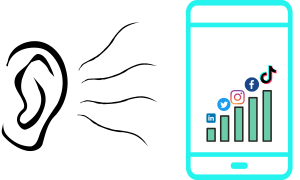25 Social Media Research
To study the impact of social media on communication, public relations professionals use a wide variety research methods from traditional, such as focus groups and surveys, to social research, such as social media monitoring and listening. Traditional research, discussed in the previous chapter, can be very slow and expensive. It can take up to six months to collect and analyze data using traditional methods. On the other hand, social media monitoring and listening can capture real-time insights of how publics view an organization’s service or its products. Nevertheless, traditional research remains a valuable tool to provide in-depth and more accurate information that social media monitoring and listening cannot provide.
Being able to conduct and evaluate social media research is a valued skill among PR professionals. Organizations are in constant need of professionals who can use digital tools and techniques to collect and analyse data from various social media platforms and networks, make sense of it, and apply the results to create content and evaluate programs.
Image Hotspots: Social Media Platforms
Enormous amount of information is generated online every day. Social media research today is about leveraging, organizing, and analyzing this constant flow of real-time conversations generated on social media platforms. Professionals use various digital tools, such as Meltwater and Hootsuite, to make sense of social data and use it strategically.
Social media research companies that offer social research insights, such as Brandwatch and Unmetric, are becoming more and more popular among organizations that want to optimize their social media strategies.
Freberg (2022) argues that, in many ways, social media platforms and networks resemble an online focus group because organizations are able to see what people are sharing, creating, talking about them, and can ask community a question to get their take. “This input could provide feedback about a new campaign, test out new products or spokespeople, or even determine what attributes people assign to you. On other occasions, research can inform how your brand is presented and what types of engagements, content, and voice audiences are looking for in the brand. While these are mostly positive circumstances, understanding what could potentially go wrong is an additional benefit of research. Listening for early warning signs (a string of negative reviews of a restaurant on social media, users identifying an account has been hacked, etc.) could save the brand’s financial standing and reputation” (Freberg, 2022, p. 140).
Monitoring and listening are two terms used in social media research that are related but have fundamental differences. Taylor Doolittle argues that these differences can be explained by removing the word ‘social’ and focusing on the difference between monitoring and listening more broadly. Monitoring involves watching, observing, and periodic tracking (for example, daily, weekly, annually) of any activity’s progress, while listening involves receiving and interpreting messages in the communication process. Together with the social component, these broad definitions help us understand the difference between social monitoring and social listening.
While social media monitoring is a the process of watching and observing social media conversation over time, social media listening is the process of hearing and interpreting social media conversation to understand publics and stakeholders over time (Taylor Doolittle, 2020).

Social media monitoring is “the systematic process of understanding, analyzing, and reporting insights and conversations on reputation, brand position, community health, and opinion of key audience members virtually” (Freberg, 2022, p. 140). This approach helps you to hear what people say about your organization, identify popular topics, assess, and quantify its popularity.
Freberg (2022) points out that monitoring is a systematic and sustainable area within social media measurement. The data being collected and analyzed must be connected to current communication objectives and tied with metrics and key performance indicators (KPIs). According to Maggie Whitley, the most common monitoring metrics are sentiment and volume of conversation. Sentiment is the ratio of positive to negative attitude about a topic. Volume of conversation is how many total mentions there are around your organization or topic online with filtering for comments, shares, likes, retweets, and number of views or “impressions.”
Social media listening is “about learning, exploring, and uncovering emerging trends, opportunities, activities, and issues that could impact the company either positively or negatively” (Freberg, 2022, p. 140). The main difference between monitoring and listening is time frame. According to Freberg (2022), monitoring is conducted on a long-term basis, much longer than listening, and can take place over weeks or months or even years. Monitoring is a systematic and sustainable approach to evaluating performance on social media, and it tends to be more reactive compared to listening (Freberg, 2022).
Investing in proper tools (such as Meltwater, Brandwatch, Mention, Buzzumo, or Hootsuite) and training your employees are very important in conducting social media monitoring and listening. Major social media platforms and listening tools offer their clients various training opportunities through Google Analytics Certification, Facebook Blueprint, Hootsuite Academy, HubSpot Academy, Twitter Flight School, Pinterest Academy, Snap Focus, etc.
Both social media monitoring and listening are important research approaches. Professionals cannot do just one and ignore the other. Tools and metrics can be applied to listening and monitoring separately or in combination.
References
Dollittle, T. (2020, August 7). What’s the difference between social monitoring and social listening? Bellomy. https://www.bellomy.com/blog/social-monitoring-vs-social-listening
Freberg, K. (2022). Social Media for Strategic Communication: Creative Strategies and Research-Based Applications (2nd edition). Thousand Oaks, CA: Sage.
Whitley, M. (2020, June 3). What is social monitoring? Bellomy. https://www.bellomy.com/blog/what-is-social-monitoring

